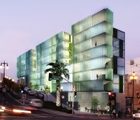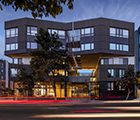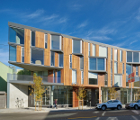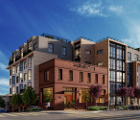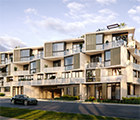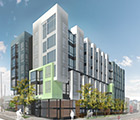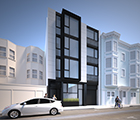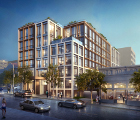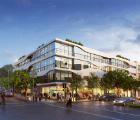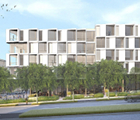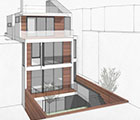PRESS
Read DM Development's latest news and press releases
SF developers struggling to fill new ground-floor retail spaces
In October 2013, developer Crescent Heights announced that New York celebrity chef Suvir Saran would open an 8,500-square-foot restaurant on the ground floor of NEMA, a 700-unit apartment complex at 10th and Market streets.
“I can’t begin to express my excitement about launching a restaurant in San Francisco and in the NEMA building particularly,” Saran said at the time.
But the restaurant never opened. About 18 months after the announcement, Saran pulled out, citing “unanticipated complications and endless delays.”
And more than four years later, all of the 13,500 square feet of retail space at NEMA sits vacant — a blank glass wall fronts Market Street instead of the lively shops and restaurants the developer had promised.
But Crescent Heights, which did not return calls seeking comment about the status of the space, is not alone when it comes to empty retail spaces in newly constructed buildings.
In a city where ground-floor retail is often required in residential developments, much of the new stock sits empty. A look at 20 housing developments on or within a few blocks of Market Street between Castro Street and Fifth Street — all completed within the last five years — found 17 vacant storefronts, about 45 percent of the total. While some of the empty spaces are relatively new, like the three storefronts at 181 Sanchez St., others, like NEMA, have been around for four or five years and have yet to land tenants.
The situation is similar on Fourth Street in Mission Bay, which is being billed as the nascent neighborhood’s shopping corridor. Only two retailers have moved in on the east side of the street, while entire blocks of storefronts remain vacant. To the north, at the 410-unit L7 project at 1222 Harrison St., the biggest recent development in SoMa, all five spacious retail spaces are empty, although signage indicates one has been leased to a furniture shop.
While housing developers lean heavily on local nightlife and retail in luring renters or buyers to their properties, interest in those matters often doesn’t seem to extend to their own buildings, said Gail Baugh, vice president of the Hayes Valley Neighborhood Association.
“Bad things happen when you abandon the street, and that is what a lot of developers are doing,” Baugh said. “Street activation is the thing that makes neighborhoods feel safe and the thing that engages neighbors with one another. The city should force developers to put in temporary uses, especially in these big spaces.”
The sluggish pace at which many of these spaces are being filled is a symptom of the weak retail sector, as well as high construction costs and zoning restrictions that limit what can go into many of the spaces, developers and brokers say.
Brian Spiers, a San Francisco builder who constructed the 115-unit Linea project at 1998 Market St. and is currently developing 60 units at 2100 Market St., said he understands why neighbors push against chain stores and prefer smaller spaces that are more amenable to mom-and-pop outlets. But bringing in retailers that fail doesn’t help the neighborhood either.
“I’ve had both really good and really bad experiences with retail,” he said. “The neighborhood wants smaller spaces in the hopes of getting a non-formula retailer, but the challenge as a landlord is you are taking a chance on someone who has never run a business and is not well-capitalized.”
Brokers point out that broad categories of retailers — clothing, shoes, hardware — are losing market share to online sales and are contracting, not expanding. And the categories that are growing and looking for space — banks, medical services, gyms, cannabis dispensaries and offices for everything from real estate agents to architects — are not always popular with neighbors and require authorization from the Planning Commission, which can be costly and take up to year.
“Who doesn’t want a hardware store?” Spiers said. “But we have to be realistic. There is not enough business to support too many hardware stores. They have to be able to pay the rent. People are staying home and shopping on their computers. There are not as many people moseying up and down the street as there used to be.”
The onetime staple of urban neighborhoods — the corner store — is completely absent from the new developments. While revenue at corner stores is often driven by the sale of booze, new liquor licenses are prohibited in many neighborhoods. Daniel Sider, senior adviser for special projects at the Planning Department, said the department is looking for ways to open new convenience stores, places that sell everything from fruit and veggies to toilet paper to lottery tickets. But it’s challenging.
“It is liquor that subsidizes the other goods sold at many small corner markets,” Sider said. “We have rules that make it difficult to open a traditional corner store. That is something we are looking at.”
But not all the news is gloomy when it comes to retail in new development. Over the past year, Equity Residential has opened three projects in or near Showplace Square: One Henry Adams, which has 150 units and 8,600 square feet of retail; 855 Brannan St., which has 434 units and 16,000 square feet of retail; and 1010 Potrero, with 453 units and 14,000 square feet of retail.
Since March, Equity has signed 10 retail leases in the three complexes totaling 20,855 square feet, said Drew Sullins, vice president of development. The new leases include the San Francisco taco bar El Pipila, the wood-fired pizza spot SoMa Slice, a Peet’s coffee outlet and the falafel restaurant Truly Mediterranean. California College of the Arts will open a new flex space for gallery exhibitions, screenings and events.
Sullins said Equity’s retail consultants are involved in every step of the design and construction process, and retail is regarded as an amenity for residents.
“Signing a lot of chain retailers would have been easier, but that’s not the neighborhood vibe” they’re going for, he said. “A nice cafe could very well make the difference between someone deciding to sign a lease in one of our buildings versus going somewhere else.”
One group taking advantage of the city’s development boom is the Boba Guys, who have opened locations at the 8 Octavia condominiums in Hayes Valley and at 1010 Potrero Ave.
Boba Guys co-founder Bin Chen said owners of new developments are increasingly reaching out to his milk tea group, which started on 19th Street in the Mission. Chen said that he and his partners were lucky in that Equity Residential and DM Development, the builder of 8 Octavia, were willing to take a chance on operators “off the beaten path” with limited experience and no outside investors. That has not been true of other developers, he said.
“A lot of developers don’t care whether they get a Boba Guys or a random bank,” he said. “They don’t seem incentivized to lease the retail space. They are concerned with the apartments.”
Supervisors Jane Kim and Aaron Peskin say they are exploring ways to pressure property owners to fill up their empty spaces. Kim said that she looked at a tax on vacant space, something New York City is also considering, but that vacancy taxes have “unintended consequences that are difficult to parse out.”
“It’s hard to just tax landlords who are keeping spaces vacant on purpose or because they have a higher expectation of rent versus those who are trying but can’t find tenants,” she said.
Peskin said he is looking at a modest fee for property owners, which would cover the cost to the city of keeping the space vacant — it could cover things like trash removal and grafitti remediation, which are more common in front of empty spaces.
